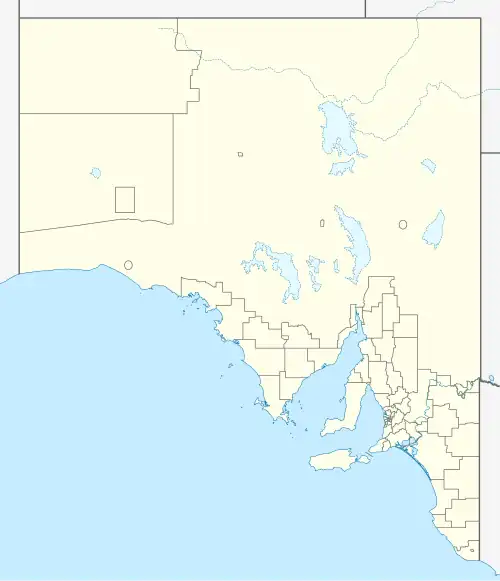Angorichina

.jpg)
.jpg)
Angorichina is a pastoral lease, 640 square kilometres (247 sq mi) in area, in the Flinders Ranges in the Australian state of South Australia. Its three small permanently inhabited places, dispersed on an east-west axis 18 kilometres (11 miles) long, are Angorichina Station, Blinman, and Angorichina Village.
Angorichina Station
History
The lease was first taken up by Septimus Boord in 1853.[1] In 1859, the property was visited by the surveyors Selwyn and Goyder and by the Governor of South Australia, Richard MacDonnell. Later the same year a shepherd on Angorichina Station, Robert Blinman, first discovered copper and took out a mining lease, which later became the Blinman mine.[2]
Walter Henry McFarlane acquired Angorichina in the early 1920s after disposing of Warrioota Station.[3] In 1941 the 1200-square-mile (3108 km2) property was carrying a flock of 38,000 sheep that produced 1300 bales of wool.[4]
As of August 2025, the property had been in the Fargher family for four generations.[5]
Today
As of 2025, the owners are Di and Ian Fargher (the fifth generation of Farghers[6]), and Angorichina Station is still a working sheep station. The renovated 1860s-era homestead, 6 kilometres (4 miles) east of Blinman, together with the garden cottage, accommodates up to eight guests, with only a single group hosted for each stay.[5][7]
The property is located around 10 km (6.2 mi) east of Blinman,[8] and extends over around 150,000 acres (61,000 ha).[6]
Populated places
Blinman
Blinman, the small township within the pastoral lease had a population, in 2021, of 43.[9]
Angorichina Village
Angorichina Village is a small tourist village, 12 kilometres (7.5 miles) west of the Angorichina Station homestead, which provides accommodation, a caravan park and some services.[10]
The site was originally established in 1927 as Angorichina Hostel by the Tubercular Soldiers Association as a sanatorium for returned servicemen of World War I.[1][11]
Paleontological importance
There are important complex fossil reefs on the property, recording the emergence of small fauna, such as molluscs, arthropods, brachiopods, and tommotiids. There are also fossils of archaeocyaths and calcimicrobes, and one of the sites records the extinction of the archaeocyathids resulting from environmental changes in the early Cambrian.[12]
The oldest known corallimorpharia have been observed in Balcoracanna Gorge, and the first and only known articulated tommotiid specimens of Eccentrotheca helenia and Paterimitra pyramidalis were identified in the exposed strata of the Bunkers Range. This range also hosts diverse species of brachiopods, palaeoscolecid worms, bradoriid arthropods, and molluscs, along with an important silicified trilobite assemblage representative of the "Pararaia bunyerooensis Zone".[12]
The fossils are managed under the Pastoral Land Management and Conservation Act 1989, and it is intended to create a formal conservation agreement with the Angorichina Station.[12]
World Heritage bid
The Angorichina fossils are one of a group of seven geographically separate areas that are part of the Flinders Ranges geological successions where abundant and diverse arrays of fossils show how animal life began on Earth over a period of 350 million years. These areas were submitted to the UNESCO World Heritage Centre for consideration as a World Heritage Site under criterion (viii) on 15 April 2021, and as of August 2025 remain on the tentative list.[12] The nomination will be voted on in 2026.[13]
In popular culture
A 2011 debut novel by Marion Grace Woolley is titled Angorichina. It tells the story of the tuberculosis hospice in the early 1930s through the eyes of four characters.[14]
See also
References
- ^ a b Manning, Geoffrey H. (2012). "A compendium of the place names of South Australia". The State Library of South Australia. Retrieved 10 January 2022.
- ^ "Angorichina Station". Flinders Ranges Research. 2012. Retrieved 25 August 2013.
- ^ "Obituary". The Advertiser. Adelaide: National Library of Australia. 9 January 1946. p. 5. Retrieved 9 August 2014.
- ^ "Travelling Around With Sunflower"". The Chronicle. Adelaide: National Library of Australia. 18 December 1941. p. 39. Retrieved 14 October 2014.
- ^ a b "Home". Angorichina Station. 13 February 2025. Archived from the original on 23 May 2025. Retrieved 13 August 2025.
- ^ a b "Accommodation : 1800's Original Shearers Quarters, Little Paddock Homestead, Camping". Accommodation. Retrieved 13 August 2025.
- ^ "Accommodation". Angorichina Station. Retrieved 13 August 2025.
- ^ "Location". Angorichina Station. Retrieved 13 August 2025.
- ^ "2021 Blinman, Census All persons QuickStats". Australian Bureau of Statistics. Retrieved 14 August 2025.
- ^ "About Angorichina Village". Flinders Ranges and Outback. 18 July 2025. Retrieved 13 August 2025.
- ^ Wilson, John (2021). The train to Oodna-Woop-Woop: a social history of the Afghan Express. Banksia Park, South Australia: Sarlines Railway Books. p. 89. ISBN 9780646842844.
- ^ a b c d "Flinders Ranges". UNESCO World Heritage Centre. 21 April 2025. Archived from the original on 30 June 2025. Retrieved 14 August 2025.
- ^ Dillon, Meagan (21 April 2023). "Set in stone". ABC News. Retrieved 3 May 2023.
- ^ "How I got my book published: An interview with author, Marion Grace Woolley". Free Writers' Newsletter. 5 June 2011. Retrieved 14 August 2025.